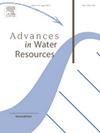揭示地表-地下流动相互作用的鲑鱼redd
IF 4.2
2区 环境科学与生态学
Q1 WATER RESOURCES
引用次数: 0
摘要
雌性鲑鱼把它们的卵埋在河床的砾石中,它们在那里产卵,然后用第二个坑里的砾石覆盖,形成一个表面粗糙的沙丘状结构,叫做redd。赤潮和水流之间的相互作用促使地表水通过卵囊流入沉积物,并在峰顶下游重新出现。这些向下和向上的流动形成了下潜交换,这对胚胎的发育至关重要,因为它调节了卵袋的温度状态,并向胚胎输送富氧的地表水。在这里,我们通过实验研究(1)红色表面粗糙度和(2)卵袋存在对不同表面水力学下红色诱导的低流的影响,通过构建透明颗粒制成的合成红色,我们可以在循环水槽中使用非侵入技术测量自由流、近床流和间隙流速度。结果表明,通过redds的流量与弗劳德数的平方成正比,但表面粗糙度使这种关系更加复杂。卵袋的颗粒比周围的基质大,这增强了机械分散,增加了卵袋内的水混合,并导致向卵袋方向的下流收敛。总的来说,这些结果表明,以鲑鱼保存为重点的河流建模研究应该考虑表面粗糙度以及筑巢环境中不同的水力传导率。本文章由计算机程序翻译,如有差异,请以英文原文为准。
Unveiling surface-subsurface flow interactions of a salmon redd
Female salmonids bury their eggs in streambed gravel by digging a pit where they lay their eggs, which they then cover with gravel from a second pit, forming a rough-surfaced dune-like structure called a redd. The interaction between a redd and the stream flow induces surface water to flow into the sediment, through egg pockets, and reemerge downstream of the crest. These downwelling and upwelling flows form the hyporheic exchange, which is vital for the embryos’ development because it regulates the egg pocket temperature regime and delivers oxygen-rich surface water to the embryos. Here, we experimentally investigate the effects of (1) redd surface roughness and (2) egg pocket presence on redd-induced hyporheic flows under different surface hydraulics by constructing a synthetic redd made of transparent grains that allow us to measure freestream, near-bed, and interstitial flow velocities with non-invasive techniques in a recirculating flume. Results indicate that flow through redds is proportional to the squared Froude number, but surface roughness causes this relation to be more complex. The egg pocket, having larger grains than the surrounding matrix, enhances mechanical dispersion, which increases water mixing within the egg pocket and causes convergence of downwelling flows towards the egg pocket. Overall, these results show that river modeling studies focused on salmonid preservation should consider surface roughness as well as varying hydraulic conductivities within the nesting environments.
求助全文
通过发布文献求助,成功后即可免费获取论文全文。
去求助
来源期刊

Advances in Water Resources
环境科学-水资源
CiteScore
9.40
自引率
6.40%
发文量
171
审稿时长
36 days
期刊介绍:
Advances in Water Resources provides a forum for the presentation of fundamental scientific advances in the understanding of water resources systems. The scope of Advances in Water Resources includes any combination of theoretical, computational, and experimental approaches used to advance fundamental understanding of surface or subsurface water resources systems or the interaction of these systems with the atmosphere, geosphere, biosphere, and human societies. Manuscripts involving case studies that do not attempt to reach broader conclusions, research on engineering design, applied hydraulics, or water quality and treatment, as well as applications of existing knowledge that do not advance fundamental understanding of hydrological processes, are not appropriate for Advances in Water Resources.
Examples of appropriate topical areas that will be considered include the following:
• Surface and subsurface hydrology
• Hydrometeorology
• Environmental fluid dynamics
• Ecohydrology and ecohydrodynamics
• Multiphase transport phenomena in porous media
• Fluid flow and species transport and reaction processes
 求助内容:
求助内容: 应助结果提醒方式:
应助结果提醒方式:


